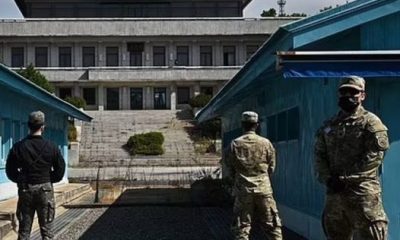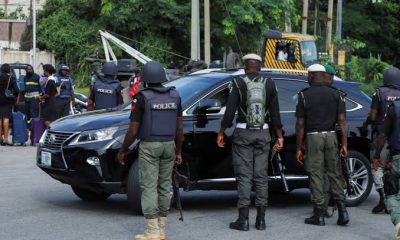Comments and Issues
Ten lessons from North Korea’s nuclear program
Published
8 years agoon
By
Olu Emmanuel
By RICHARD N. HAASS
North Korea has produced a number of nuclear warheads and is developing ballistic missiles capable of delivering them around the world. Many governments are debating how to prevent or slow further advances in North Korea’s capacity and what should be done if such efforts fail.
These are obviously important questions, but they are not the only ones. It also is important to understand how North Korea has succeeded in advancing its nuclear and missile programs as far as it has, despite decades of international efforts. It may be too late to affect North Korea’s trajectory decisively; but it is not too late to learn from the experience. What follows are ten lessons that we ignore at our peril.
First, a government that possesses basic scientific knowhow and modern manufacturing capability, and is determined to develop a number of rudimentary nuclear weapons, will most likely succeed, sooner or later. Much of the relevant information is widely available.
Second, help from the outside can be discouraged and limited but not shut down. Black markets exist any time there is a profit to be made. Certain governments will facilitate such markets, despite their obligation not to do so.
Third, there are limits to what economic sanctions can be expected to accomplish. Although sanctions may increase the cost of producing nuclear weapons, history suggests that governments are willing to pay a significant price if they place a high enough value on having them. There is also evidence that some or all of the sanctions will eventually disappear, as other governments come to accept the reality of a country’s nuclear status and choose to focus on other objectives. That is what happened in the case of India.
Fourth, governments are not always willing to put global considerations (in this case, opposition to nuclear proliferation) ahead of what they see as their immediate strategic interests. China opposes proliferation, but not as much as it wants to maintain a divided Korean Peninsula and ensure that North Korea remains a stable buffer state on its borders. This limits any economic pressure China is prepared to place on North Korea over its nuclear efforts. The United States opposed Pakistan’s development of nuclear weapons, but was slow to act, owing to its desire in the 1980s for Pakistani support in fighting the Soviet Union’s occupation of Afghanistan.
Fifth, some three quarters of a century since they were first and last used, and a quarter-century after the Cold War’s end, nuclear weapons are judged to have value. This calculation is based on security more than prestige.
Decades ago, Israel made such a calculation in the face of Arab threats to eliminate the Jewish state. More recently, Ukraine, Libya, and Iraq all gave up their nuclear weapons programs either voluntarily or under pressure. Subsequently, Ukraine was invaded by Russia, Iraq by the US, and Libya by the US and several of its European partners. Saddam Hussein in Iraq and Muammar el-Qaddafi in Libya were ousted.
North Korea has avoided such a fate, and the third generation of the Kim family rules with an iron fist. It is doubtful that the lesson is lost on Kim Jong-un.
ALSO SEE: North Korea warns US, as it launches another ballistic missile
Sixth, the Non-Proliferation Treaty – the 1970 accord that underpins global efforts to discourage the spread of nuclear weapons beyond the five countries (the US, Russia, China, the United Kingdom, and France) that are recognized as legitimate nuclear weapons states for an unspecified but limited period of time – is inadequate. The NPT is a voluntary agreement. Countries are not obliged to sign it, and they may withdraw from it, with no penalty, if they change their mind. Inspections meant to confirm compliance are conducted largely on the basis of information provided by host governments, which have been known not to reveal all.
Seventh, new diplomatic efforts, like the recent ban on all nuclear weapons organized by the United Nations General Assembly, will have no discernable effect. Such pacts are the modern-day equivalent of the 1928 Kellogg-Briand Pact, which outlawed war.
Eighth, there is a major gap in the international system. There is a clear norm against the spread of nuclear weapons, but there is no consensus or treaty on what, if anything, is to be done once a country develops or acquires nuclear weapons. The legally and diplomatically controversial options of preventive strikes (against a gathering threat) and preemptive strikes (against an imminent threat) make them easier to propose than to implement.
Ninth, the alternatives for dealing with nuclear proliferation do not improve with the passage of time. In the early 1990s, the US considered using military force to nip the North Korean program in the bud, but held off for fear of triggering a second Korean War. That remains the case today, when any force used would need to be much larger in scope and uncertain to succeed.
Finally, not every problem can be solved. Some can only be managed. It is much too soon, for example, to conclude that Iran will not one day develop nuclear weapons. The 2015 accord delayed that risk, but by no means eliminated it. It remains to be seen what can be done vis-à-vis North Korea. Managing such challenges may not be satisfying, but often it is the most that can be hoped for.
Richard N. Haass, President of the Council on Foreign Relations, previously served as Director of Policy Planning for the US State Department (2001-2003), and was President George W. Bush’s special envoy to Northern Ireland and Coordinator for the Future of Afghanistan.
- Culled from project Syndicate
You may like


Global tension rises as Un orders North Korea military to prepare for war


Kim Un travels in train to meet Putin in Russia


US Soldier arrested by North Korea for unauthorized crossing


Fresh tension in Korean Peninsula as North, South Korea engage in gun battle


US/South Korea “Max Thunder” an “Intentional Provocation” – North Korea warns


North Korea to end nuclear programme on this condition
Trending

 Politics6 days ago
Politics6 days agoPRP conducts ward, LG congresses in Lagos, elects new executives

 Latest1 week ago
Latest1 week agoSEARP decries delay in enforcing judgment on N6tn NDDC misappropriation scandal, threatens suit against AGF Fagbemi

 News6 days ago
News6 days agoHeart of Gold Empowerment Outreach bolsters 30 indigent’s economic status in Edo State

 Business4 days ago
Business4 days agoControversy trails Dangote Refinery as stakeholders Allege systemic pushback against local investment

 Business1 week ago
Business1 week agoFG to lose N1.4trn annually as corporate tax cut takes effect in 2026

 Business7 days ago
Business7 days agoNDIC begins liquidation of ASO Savings, Union Homes, moves to pay insured deposits

 Crime1 week ago
Crime1 week agoPolice To Resume Tinted Glass Enforcement

 Latest7 days ago
Latest7 days agoAkpabio denies health scare, dismisses reports of collapse on London trip

